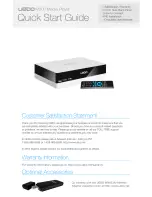
IN1608 xi Scaling Presentation Switcher • Internal Web Pages
123
HDCP Mode panel
HDCP mode either follows the encryption status of the selected input or always encrypts
the output. However, some sink devices require continuous DVI authentication trials to pass
HDCP encrypted content after a power cycle or resuming from sleep mode. Select one of
the following radio buttons (see
,
•
Follow
Input
— Encrypts the output only when required by the selected input source.
•
Always
Encrypt
Output
— Always encrypts the output, regardless of the HDCP status
of the selected input source.
•
Follow
Input
(with
continuous
DVI
trials)
— Encrypts the output only when
required by the selected input source. Use this setting when DVI sink devices initially
pass HDCP encrypted content, but intermittently display a green HDCP notification
screen after a power cycle or resuming from sleep mode.
•
Always
Encrypt
Output
(with
continuous
DVI
trials)
— Always encrypts the
output regardless of the HDCP status of the selected input source. Use this setting
when DVI sink devices initially pass HDCP encrypted content, but intermittently display
a green HDCP notification screen after a power cycle or resuming from sleep mode.
•
Disable
Authentication
— Disables all output authentication and encryption. HDCP
sources do not pass.
RS-232 Insertion panel (inputs 7 and 8 and output 1C only)
The DTP twisted pair input and output ports allow you to insert RS-232 control signals
onto the same cable that carries video and audio to extend them to the over TP port on a
connected endpoint (source or sink). The control signals can be inserted two ways:
•
Ethernet to RS-232 insertion
— A control signal applied to the LAN port can be
routed to any IN1608 xi scaler DTP port.
•
Captive screw insertion
— A control signal applied to an RS-232 captive screw port
is tied directly to the same-numbered DTP port.
The insert inputs and output, whether inserted via Ethernet or captive screw connectors,
can support a baud rate up to 115200. You must physically connect a cable attached to the
captive screw connector where a control signal is to be inserted (see
page 44 for instructions on connecting cables for these insertion methods).
RS-232 Insertion panel selections
The
RS-232
Insertion
) contains a table with the following columns:
•
Port and Name
— These view-only columns list the names of the DTP inputs (
Input
7
and
Input
8
) and the DTP output (
Output
1C
), that have been detected on the unit.
•
Insertion Method
— This column contains drop-down menus from which you can
select the method of RS-232 insertion (
Captive
Screw
or
Ethernet
) for either or both
inputs.
By default,
Captive
Screw
is selected as the RS-232 insertion method for both inputs
and the output. If desired, you can select
Ethernet
as the method, in which case you
must also select the baud rate, data bits, stop bits, and parity from the other drop-down
menus for the input or output.














































